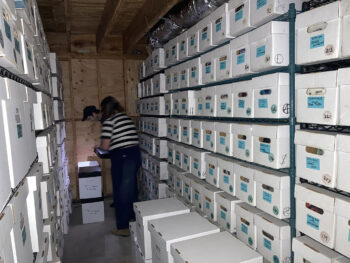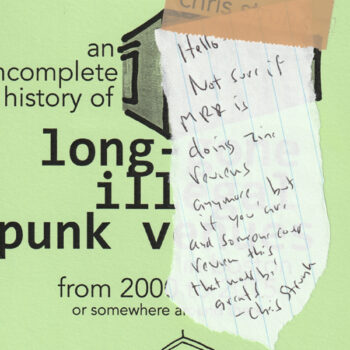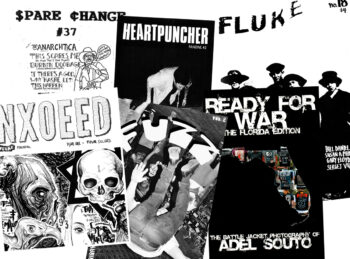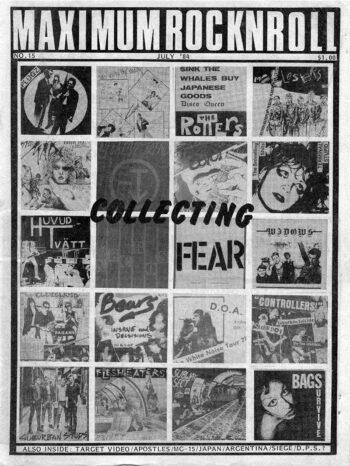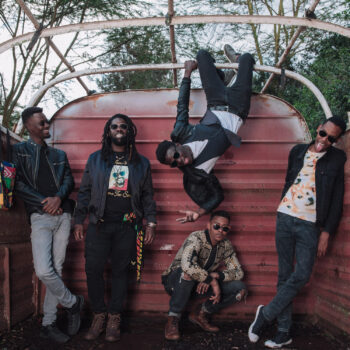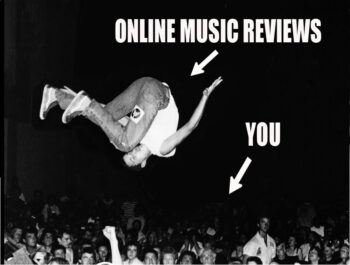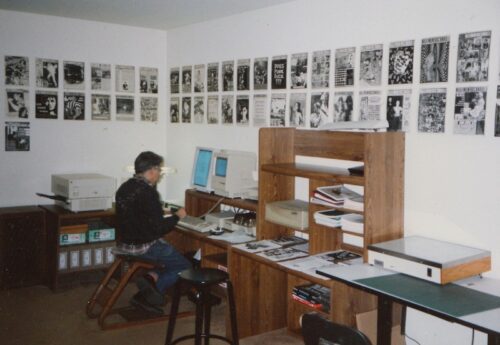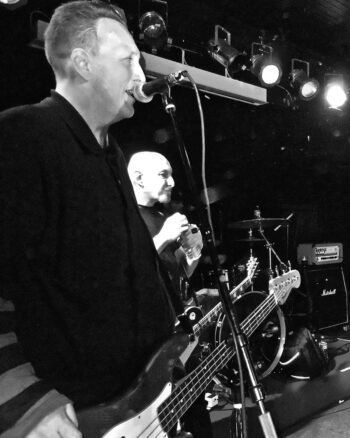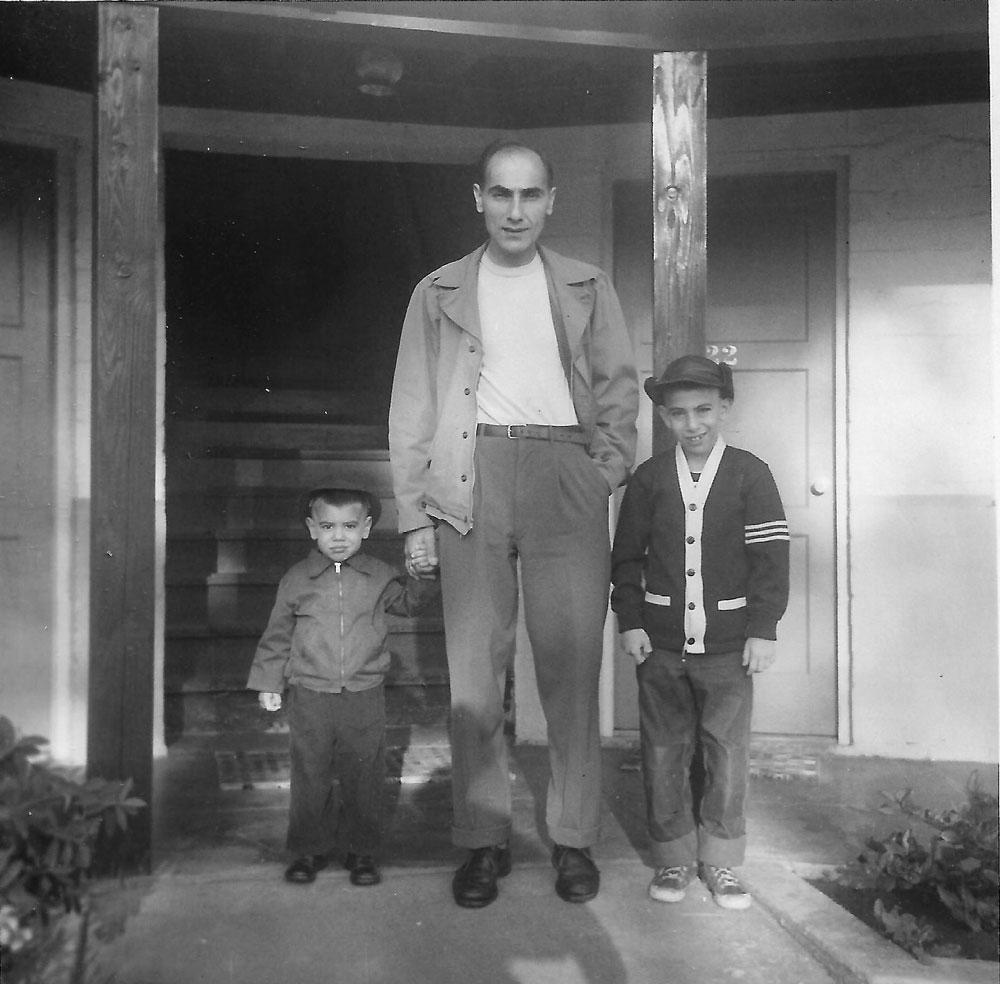White Riot: Another Failure…
White Riot: Punk Rock and the Politics of Race (on Verso Books, edited by Stephen Duncombe and Maxwell Tremblay) just hit the academic circuit claiming to be the “Ultimate Collection” of writings about punk and race. While many, and I mean many, many, many of us punks of color whom this book claims to be representing by way of other peoples voices, disagree, there seems to be very little attention paid to these critiques. I personally plan on responding to the book, but thankfully we have this review in the current issue of MRR. Resulting from many conversations and discussions, Golnar Nikpour, former coordinator, active punk, scholar and, yes, brown as fuck person agreed to review this highly questionable (in my opinion, shitty) book.
—Mariam
 The back cover of this recently published volume compiled and edited by NYU professor Stephen Duncombe and New School doctoral student (and frequent MRR book reviewer) Maxwell Tremblay proclaims confidently that White Riot is a “comprehensive” and even “definitive” study of punk’s racial politics; this book, we are told, is “the ultimate collection on punk and race.” Compiling both non-academic and academic writings—i.e., primary material culled from zines and records, and secondary material culled from books and journals on scholarly presses—White Riot attempts to gather and assess the writings of a movement the authors tell us is obsessed with race, but is often unable or unwilling to contend with its own racial contradictions and implications.
The back cover of this recently published volume compiled and edited by NYU professor Stephen Duncombe and New School doctoral student (and frequent MRR book reviewer) Maxwell Tremblay proclaims confidently that White Riot is a “comprehensive” and even “definitive” study of punk’s racial politics; this book, we are told, is “the ultimate collection on punk and race.” Compiling both non-academic and academic writings—i.e., primary material culled from zines and records, and secondary material culled from books and journals on scholarly presses—White Riot attempts to gather and assess the writings of a movement the authors tell us is obsessed with race, but is often unable or unwilling to contend with its own racial contradictions and implications.
Before cracking the book open, I viewed White Riot with both skepticism and anticipation. My skepticism shouldn’t come as any surprise: the academic world has produced a silly number of texts in the name of “punk studies,” but the great majority of these studies traverse a world that has little to do with punk as I know it. At best, they are basically irrelevant the-Sex-Pistols-Were-Totally–Influenced-By-Situationism-and-Other-Serious-Things Studies, and at worst they are egomaniacal attempts to garner legitimacy (not to mention CV padding!) on the backs of DIY subculture(s). In general, I am leery of those academic “experts” whose object of study is punk, not only because I don’t consider the punk scene an intellectual little league that needs legitimacy bequeathed to it by professionals, but also because punk—auto-archiving, self-aware, and interested in its own history—operates on the premise that everyone is an expert. Still, I was hopeful about White Riot, because it promised to showcase writers, records, and ideas that have played a formative role in my own life in punk; I grew up on Los Crudos records and Mimi Nguyen zines, after all. Further, Duncombe and Tremblay were given generous access to the bountiful MRR archive, which I know for a fact could not possibly be used to tell the same old the-Clash-are-the-only-band-that-matters story… or could it?!
Readers of MRR are all likely to recognize that the title of White Riot is borrowed from a Clash song of the same name. Throughout the book, this song—in the form of the notion of punk-as-white riot—is used as a framing tool and constant refrain for the editors in their analysis of punk and race. Punk, we are told by Duncombe and Tremblay, is a quintessentially Anglo/American phenomenon primarily of/by/for disaffected white kids who either consciously or subconsciously (in the form of their anti-establishment posture) believe themselves to have transcended their own racial privilege. Whether they paint themselves as “white negroes” (White Riot starts of with a famous essay by Norman Mailer of that name, implicitly tracing punk’s lineage through American bohemian movements) or as “racetraitors” (the authors remind us of the thusly named—and terrible!—’90s HC band), punks are white (often middle class and suburban) folks anxious about race and their relationship to it. In other words, punk has primarily been a site where alternative models of whiteness—mostly oppositional, sometimes anti-racist, but always constitutively white—have been articulated. With this framing, the central question of whether or not punk can ever be anything other than (just) a white riot guides the editors through their project.
White Riot is broken into eight contributor-based chapters; the selections have all already been published elsewhere, which means that Duncombe and Tremblay’s efforts are predominantly in curating and introducing each piece. After an opening chapter by the editors (more on that in a sec), we are taken through chapters on the apparent roots of punk (Mailer, the MC5, the Weathermen, etc.), the concept of the “white minority,” aka the just-doesn’t-fit-into-straight-society white rebel (academic articles on the swastika in punk, interviews with Bob Noxious of the Fuck-Ups from MRR, Black Flag from Ripper, etc.), white power and punk (academic articles on skinheads, interviews with Ian Stuart of Skrewdriver from Terminal and Kieran Knutson of Anti-Racist Action from MRR, etc.), and an examination of the relationship between punk, reggae, and anti-racist politics (interviews with Paul Simonon of the Clash, excerpts from cultural critics Jon Savage and Paul Gilroy, early calls for anti-racist politics from Profane Existence, etc.). Incredibly, it is not until the sixth chapter (over 200 pages in!) of this book about race and punk that we hear from any punks of color, as virtually everything compiled up to this point (save a couple of—dare I say token—non-punk people of color, however brilliant, like James Baldwin and Paul Gilroy) is by white punk dudes, white scholar dudes, or the two white editor dudes of this book.
The aforementioned chapter six features an interview with Darryl Jenifer of Bad Brains, more academic articles, interviews with Skeeter Thompson from Scream, late ’70s Pakistani-British punkers Alien Kulture with the BBC, and Los Crudos (from their first year as a band) among others, an excerpt from the Afro-Punk script, some writings about the Taqwacore phenomenon, etc. Chapter Seven examines what the authors term the “Race Riot movement” (though I don’t remember these zines ever being codified as such in their day), with contributions from a number of ’90s zinesters led by a seminal essay by Mimi Nguyen (if you read only one thing from this collection, Mimi’s piece should be it—don’t worry, you can also find it on the internet), as well as essays by Tasha Fierce and Madhu Krishnan and others, an interview with Taina Del Valle of Anti-Product, and an extremely interesting MRR letter exchange jump-started by an writer who goes by “Just Another Nigger.” Finally, in chapter eight we are—at last!—informed that there are, indeed, punk scenes outside of the US/UK, with still more academic articles featuring ethnomusicologists lending their professional expertise in looks at contemporary scenes in Mexico City and Jakarta, Indonesia. This section ends on the piece written by Esneider from Huasipungo for the immigration issue of MRR from a few years back.
The editors’ flawed assumptions about punk’s historical trajectory are clear from their presentation of the material culled. According to White Riot, punk began (and for many years remained only) in London, NYC, and L.A. and as such was founded as a more-or-less a white movement (despite its formative—albeit troubled—relationship to reggae in London), until a political turn in the ’90s that included some punks (Crudos in particular) declaring themselves not only punk but also brown (or black), a shock for the wannabe “colorblind” but nonetheless racially-divided scene. There is then a final movement of punk from London, New York, etc. towards the so-called third world as the popularity of Green Day and the like (I shit you not, this is what this book is telling me) takes punk to such far flung places as Indonesia and Mexico in the ’90s and ’00s. It is in this final move that the authors find the most hope, telling us that if punk is to be not only a white riot, it will be because of the efforts of these non-Anglo punks.
This is a deeply problematic timeline. Most obviously, it is one that utterly excises the essential globality of punk scenes, not to mention the emergence of rock n’ roll as a transnational form long before the advent of punk. This insistence that punk travels from “the West” to “the rest”—a typical imperial trope here espoused by self-proclaimed anti-racists—ironically mirrors and reproduces racist assumptions that “the rest” of the world is living in a belated present, and that their today is not coterminous with “ours” but rather with an era that for “us”—and there is no mistaking who “we” are in this argument—is fully in the rear-view mirror.
Somehow, the editors miss numerous chances to discuss non-Anglo punk scenes even when they’re staring them right in the face. In the introduction, they relay an anecdote about encountering some young Polish punks in front of ABC No Rio in NYC: “Nearby was a group of young punks: leather, spikes, mohawks, heavy black boots, the whole bit…Blink your eyes and it could have been 1977, 1987, or 1997. Except for one thing: these punks all spoke Polish…We stood there wondering what punk meant to them…Punk, with it’s Anglo-American lineage and the dominance of English, must have also been something foreign to them, something alluring, something Other.’” (italics mine, p. 15). These punks are simply assumed to have gotten into punk rock in the US; hence, punk is transformed into something supposedly “foreign” for a bunch of Polish kids at a show. A simple Google search would have revealed the extraordinarily prolific history of Polish punk — a history that has its roots in the late ’70s (hey, just like American and British punk!) and has produced literally thousands of Polish-language bands, records, labels, distros, zines, etc. Instead of a good faith effort at getting to the bottom of this seeming paradox, the navel-gazing and presumption continues: “[Punk], we imagine, was a way to rebel (against their Polish parents) to assimilate (into this new English-speaking world), and rebel once again (against mainstream America). It was a more complicated punk experience than our own.” Um…what? First of all, if the purpose of this study is to unearth the “experience” of punk for members of different communities—immigrant and otherwise—in the US, the authors of this book didn’t have to imagine what was going through the heads of these Polish punks or wonder how they got into punk; they could have just walked up to them and asked! It seems that it is in fact the editors of White Riot who view these Polish punks as hopelessly foreign, rather than the Polish punks’ view of punk rock as such. Of course, this reveals Duncombe and Tremblay’s assumption that their “own experience” of punk—English speaking, suburban, US-based, middle-class, and white—is the norm from which others should be judged.
If the purpose of the study is not to compile and compare “experiences,” however, but rather to provide a geographically contextualized, historically attentive study of how punk scenes are implicated in, produced by, and absorbed into racialized structures of power—and of course they are—White Riot misses the mark. My comments about purpose and context point to a central problem of White Riot. Rather than limit themselves to a study of, say representations of racial difference in the U.S. punk scene in some given era—a topic with which the editors seem as though they would be more comfortable—Duncombe and Tremblay instead boast that they have provided an exhaustive study of (the entirety of the unbounded world of) punk’s relationship to race/ethnicity.
Assuming that such a “definitive” look is even possible—which is frankly doubtful—it is a huge problem that the book doesn’t even seem to know that, as early as the late-’70s, there were fertile punk scenes in any number of major global cities, most of which were not nearly as homogenous as the editors assume. From NYC to London to Warsaw to Tokyo to SÁ£o Paulo to Istanbul (yes, the first Turkish punk record is from 1977/8!) to Stockholm to Manila, punk as a phenomenon was global from its inception. This is to say nothing of hardcore, which exploded at the tail end of the 1970s—inarguably simultaneously—in tens of countries in the world. Hell, a favorite HC nurd pastime is arguing about whether the first HC band was the Middle Class from California or the SS from Japan or Lixomania from Brazil or…well, you get my point. None of this is to discount the complicated transnational networks—propped up by capitalist relations and implicated in lingering colonial structures of power as they are—in which punk has always operated, and will continue to operate.1 This is the fucked up world in which we live, and I am the last person to romanticize punk as the colorblind utopia (or gender-neutral, or transcendent of class, etc.) some scene participants with their heads in the sand tell themselves that it is. Rather, it is to say that any study of punk must take into account this global-ness—and with it the profoundly different racial/ethnic/class/gender classifications that are at work in any given context (this means, in part, that we cannot afford to only see race in black and white, or only think of race in one way)—particularly if it hopes to understand how something like race or ethnicity is navigated by punks around the world. One cannot simply quote the Clash and be done with it.2
To be fair, the authors do admit that the “claim that punk is just a white riot” is a “dubious” one (213), but they nonetheless replicate this logic over and over (and over and over) throughout the book. From the opening chapter, which promotes the idea that punk is primarily a terrain in which oppositional whiteness is navigated (“Punk offered a space for young Whites growing up in a multicultural world to figure out what it meant to be White”), to the final chapter, which needs the help of professional American (and Canadian) anthropologists and ethnomusicologists (!!!) to tell us about punk scenes in Mexico and Indonesia (apparently these punks do not know how to speak or write for themselves), punk is understood as something that travels from “us” to “them.”
Ironically, some stern admonitions are leveled against other punks/critics who would whitewash punk (one can’t help but recall the old adage about glass houses and casting stones). For instance, despite spending the entire introduction framing punk as (only) a terrain through which to wrestle with whiteness and white identities, Duncombe closes on the claim that “…once punk is indelibly White [as in his book, presumably!] the genuine contributions of Black, Latino, Asian, and other punks of color tend to get erased” (5). Nowhere is this (true!) claim truer than in White Riot. But even the famously white early ’80s USHC scene is not as lily-white as the editors seem to believe. Black Flag, the Germs, the Adolescents, the Fix, Dead Kennedys, Crucifix, Void, Bad Brains, Suicidal Tendencies — almost every single one of the most popular early ’80s USHC bands featured one or more punks of color! This is to say nothing of plenty of lesser known bands, as well as influential zine editors like Tim Tonooka of Ripper, V.Vale of Search & Destroy, and hey even Tim Yohannan, first of three Iranian coordinators of Maximumrocknroll. Most of this history is simply not mentioned by White Riot. Of course, this list is not meant as a tokenizing gesture, a celebration of punk “multiculturalism,” or a diagnosis of a clean bill of racial health for the punk scene. On the contrary, it is just meant to further question Duncombe and Tremblay’s frustrating understanding of punk’s pure “origins” in Anglo whiteness.
Unfortunately—protests to the contrary notwithstanding—Duncome and Tremblay’s project seems to suffer from the impossible and problematic desire for a fully “fixed” and “post-racial” punk that lives up to its promises of offering a subversive whiteness that transcends race, not for the sake of the marginalized punk POC, but for the guilty conscience of the (to borrow from Mimi Nguyen) whitestraightboy punk who has had to wake up to the fact that calling oneself a race traitor doesn’t change one’s ability to access racial privilege, but who would nonetheless like punk to be a scene devoid of racial contradictions. The editors of this volume—who clearly see themselves as the punk norm—first posit punk as quintessentially white (i.e. inauthentic as an oppositional culture after all! damn it, we’ve been duped!), and then practically beg punks of color (here presented as authentic bearers of pure resistance) to somehow absolve this white scene of its dirty racial history. This to me is the ultimate in both the hubris of racial privilege and the uselessness of guilty liberal hand wringing.
—Golnar Nikpour
1 It is perhaps a bit off topic for the main body of this review, and may be too academic for some, but I’d like to propose an alternative way to discuss the emergence of punk in the late ’70s, which could prove more useful for punks in studying and contextualizing punk history. It seems to me that punk—I am speaking here of its late ’70s iteration—is a product of the 20th century movement of capital and peoples, insofar as it is one in a number of cultural (and subcultural) movements that are impossible to imagine without the prior two centuries of global urbanization and proletarianization. Thinking about punk in the context of urban space provides us with new methodological tools and questions, because the emergence of the cosmopolitan capitalist metropolis is a reality of both the colony and the metropole. This could help explain why in 1976-78 we see punk scenes not only in London and New York but also in Istanbul, SÁ£o Paulo, Tokyo, Mexico City, Stockholm, Warsaw, etc. If there was a punk scene in Istanbul before there was a punk scene in say, suburban Iowa or rural Turkey—and there was, as far as I know—then the movement of ideas is not from “west” to “rest” but rather a product of a particular historical moment in the global city, a moment that is rife with tensions between not only colony and metropole, but also town and country. (This way of thinking also allows us to avoid the elision of class, political economy, gender relationships, etc.)
2One anecdote may help illustrate my point about the importance of context and history. In 2004, Japanese HC sweethearts Framtid—my favorite band in the world—were supposed to travel to the US for a week-long West Coast tour. In the end, they were disallowed from leaving Japan because their drummer Shin—a member of a many generations old Korean-Japanese community that emigrated to Japan from Korea as cheap labor, war refugees, or forcibly conscripted soldiers in the context of Japanese colonial rule of Korea—isn’t allowed Japanese citizenship, despite having been born and raised in Japan. This colonially mitigated relationship to the state that this punk calls home has nothing to do with the racial politics about which the Clash sing. And yet, this legally enforced marker of ethnic difference between one punk and his bandmates couldn’t help but mediate their relationships to punk.

